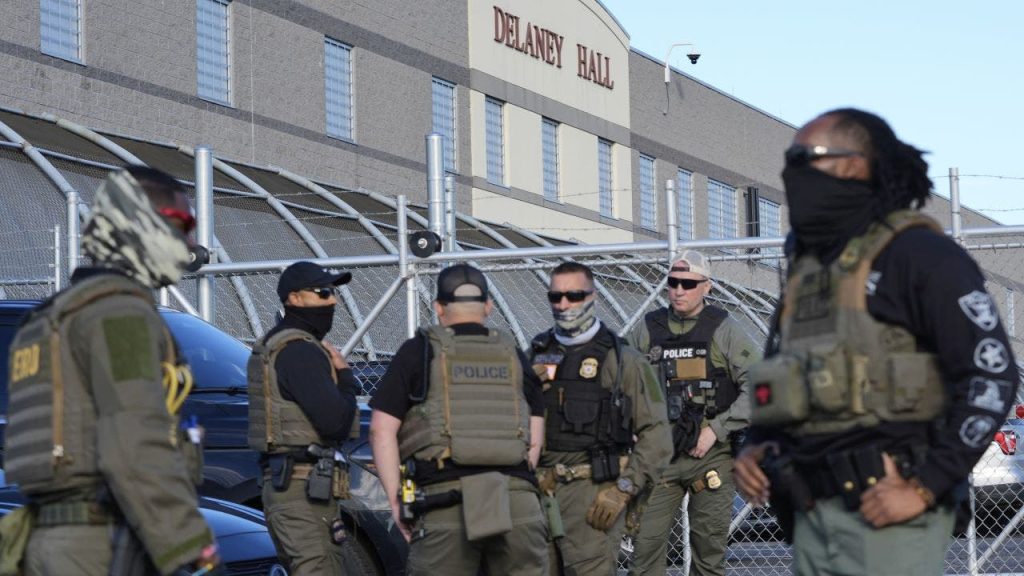In a significant protest, approximately 50 clergy members gathered outside the Delaney Hall Detention Center in Newark, New Jersey, on Monday. The demonstration aimed to oppose the detention of individuals at the facility, which has been a contentious issue in recent weeks. Linked arm in arm, the protesters chanted and sang songs, pledging to block the gates of the facility until they were arrested. This act comes shortly after lawmakers stormed the same gates during their own protest last week, highlighting ongoing tensions surrounding immigration enforcement policies.
| Article Subheadings |
|---|
| 1) Background of the Protests |
| 2) The Role of Clergy Members |
| 3) Recent Incidents at Delaney Hall |
| 4) Government Response and Community Reaction |
| 5) Future Implications of the Protests |
Background of the Protests
The protests surrounding the Delaney Hall Detention Center have arisen amidst growing concerns about the treatment of detainees within the facility. These concerns are part of a broader national dialogue regarding the controversial practices of ICE and its impact on immigrant communities. As frustrations have mounted in recent months, various groups have mobilized to express their dissent, with the clergy members’ recent actions being one of the most prominent demonstrations. The decision to gather outside the facility comes on the heels of various legislative actions and public outcries against the harsh realities many immigrants face in detention centers.
The Role of Clergy Members
Clergy members from Faith in N.J. and Faith in Action orchestrated the protest, advocating for more humane treatment of immigrants detained at Delaney Hall. By linking arms outside the facility and preparing to be arrested, these clergy members are not only drawing attention to their cause but also embodying a commitment to nonviolent protest. Several speakers during the demonstration also offered prayers for the detainees, highlighting their solidarity with those affected by immigration laws. This spiritual aspect of the protest aims to speak to the moral imperative of treating all individuals with dignity, regardless of their immigration status.
Recent Incidents at Delaney Hall
The protests follow an intense confrontation at the Delaney Hall Detention Center when three Democratic lawmakers, including Reps. LaMonica McIver, Bonnie Watson Coleman, and Rob Menendez, attempted to conduct an oversight visit. This action led to allegations of unlawful arrest against Newark Mayor Ras Baraka, who was charged with trespassing during the lawmakers’ visit. Officials claim that the protestors and the mayor were disruptive, escalating tensions between local authorities and federal agents. The detention center has recently been characterized by officials as housing dangerous individuals, including violent criminals, complicating the narrative surrounding the protests.
Government Response and Community Reaction
The Department of Homeland Security has been vocal in its defense of the operations at Delaney Hall, describing the detainees as serious offenders. This narrative is central to the agency’s justification for the detention of these individuals. Recent statistics reveal that a large segment of the public supports the deportation of undocumented immigrants, especially those with criminal histories. As such, community reactions remain mixed; while some support the clergy’s efforts, others feel strongly about strict immigration enforcement. Polls show that approximately 83% of Americans are in favor of deporting at least some illegal immigrants, a sentiment that has fueled governmental policies supporting aggressive immigration enforcement.
Future Implications of the Protests
The continued activism from clergy members and local lawmakers signals a potential shift in how immigration policies may be challenged in the future. As these protests gain media attention, they may inspire more widespread actions from various advocacy groups and community leaders. The outcomes of these protests could shape public perception and policy-making regarding immigration enforcement, especially in areas with significant immigrant populations. With the spotlight on situations at detention facilities like Delaney Hall, further dialogues surrounding humane immigration practices may emerge.
| No. | Key Points |
|---|---|
| 1 | Approximately 50 clergy members protested outside the Delaney Hall Detention Center. |
| 2 | The protest is part of broader concerns regarding the treatment of immigrants in detention. |
| 3 | An earlier incident involved the arrest of Newark’s Mayor during a visit to the facility. |
| 4 | The Department of Homeland Security has defended the facility’s operations amid public dissent. |
| 5 | Future protests may influence public opinion and policies on immigration matters. |
Summary
The protests at the Delaney Hall Detention Center highlight an ongoing national conversation about immigration enforcement and human rights. As clergy and lawmakers mobilize to denounce conditions for detainees, their actions could potentially reshape public discourse and influence policies moving forward. The increasing tensions between various stakeholders reveal deep-seated divisions on how best to address immigration issues in America.
Frequently Asked Questions
Question: What is the purpose of the protests at Delaney Hall?
The protests aim to highlight the treatment of immigrants detained at the facility and advocate for human rights and humane immigration policies.
Question: Who were the primary participants in the protest?
Approximately 50 clergy members from Faith in N.J. and Faith in Action were the primary participants in the protest.
Question: What significant events led to these protests?
The protests were sparked by recent actions by Democratic lawmakers who attempted to conduct an oversight visit at the facility, resulting in arrests and confrontations.
